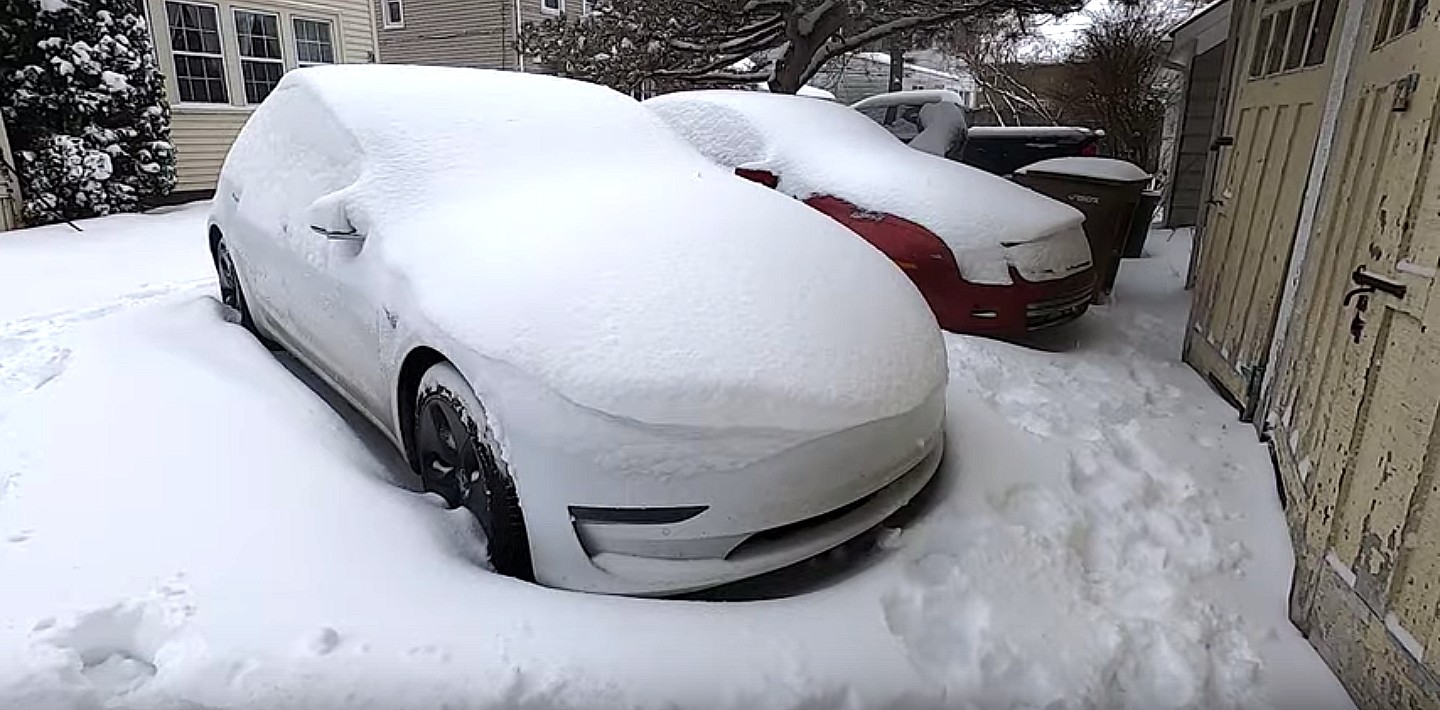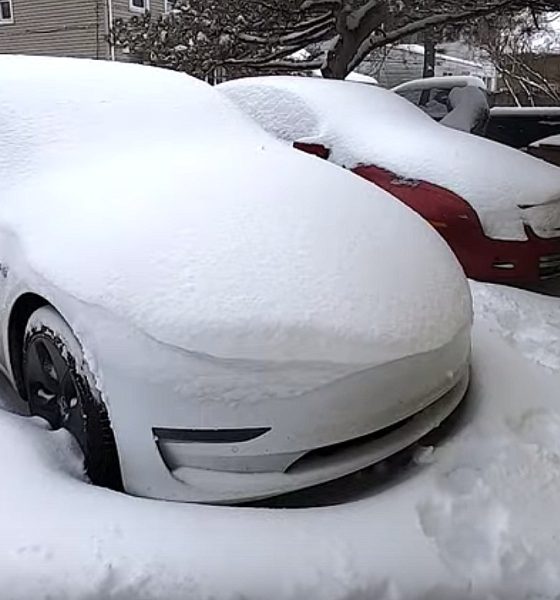

Lifestyle
Tesla Model 3 takes on gas-powered Ford in winter defroster showdown: Who melts first?
When six inches of snow is piled on top of your car, what kind of vehicle is superior in its defrosting capabilities: A Tesla Model 3, or an internal combustion engine vehicle? The owner of both a Model 3 and a Ford Fusion pit the two vehicles against one another in the ultimate “defroster showdown” to determine what vehicle would be better suited for melting away snow and ice.
Aaron Jackson of the Charging Chats YouTube channel demonstrated the effectiveness of both vehicle’s defroster systems after a six-and-a-half inch snowstorm struck his home state of Michigan. Jackson woke up to the snow covering his two vehicles and decided it would be a perfect opportunity to show how an all-electric Model 3 would perform in melting away snow when up against a traditional gas-powered engine.
After starting the two vehicles, Jackson set a timer in thirty-minute intervals. After the first thirty minutes of testing, both cars had successfully cleared their side windows and front grilles of snow.
After the second half-hour interval, the Tesla was beginning to become more visible than the Ford. Nearly the entire front hood of the Model 3 was visible as the snow slid off during the defrosting process. The Fusion was still covered for the most part, but was melting the snow at a similar rate.
Jackson determined the winner by breaking the test down into three different categories: convenience, snow cover, and how much work was leftover after letting the cars defrost on high heat for an hour.
Convenience was an easy win for the Tesla according to Jackson. “I give it to the Tesla, hands down. Just the functionality of the app, I can control it, I can start the car, warm it up, change the temperature to whatever I want it to be,” he said. While mentioning that other vehicles do have a remote start option, he still gives the advantage to his Model 3 simply because of the convenience and accessibility the app gives him.
Snow cover was a tie because both vehicles still had around the same amount of snow covering the car after the hour of defrosting. The Tesla did have less on the hood and Jackson credits the vehicle’s unique shape and design for assisting with that.
The final category of how much work remained for Jackson after the hour defrosting went to the Tesla as well. “There was the same amount of snow on both cars, but it actually cleaned off of the Tesla a lot easier than the Fusion. I think that is because of the design whereas my Fusion still has a good amount of snow on the roof of it.”
Jackson states the Tesla was the victor in the assessment as the shape and design of the vehicle certainly did assist him in an easier snow removal process. However, he did note that both vehicles did a good job of defrosting the snow and he was happy with the performance of the Fusion as well.
Tesla’s vehicles are great for any kind of weather and they are suited for both warm and cold climate driving. Each vehicle is equipped with a series of heated parts, like wheels, cameras, wipers and steering wheels so comfortability is at a maximum for drivers who are forced to brave the cold winter months.
You can watch Aaron Jackson’s defrost test of the Tesla Model 3 and Ford Fusion below.

Lifestyle
Tesla Model S Plaid battles China’s 1500 hp monster Nurburgring monster, with surprising results
There is just something about Tesla’s tuning and refinement that makes raw specs seem not as game-changing.

The Tesla Model S Plaid has been around for some time. Today, it is no longer the world’s quickest four-door electric sedan, nor is it the most powerful. As per a recent video from motoring YouTube channel Carwow, however, it seems like the Model S Plaid is still more than a match for some of its newer and more powerful rivals.
The monster from China
The Xiaomi SU7 Ultra is nothing short of a monster. Just like the Model S Plaid, it features three motors. It also has 1,548 hp and 1,770 Nm of torque. It’s All Wheel Drive and weighs a hefty 2,360 kg. The vehicle, which costs just about the equivalent of £55,000, has been recorded setting an insane 7:04.957 at the Nurburgring, surpassing the previous record held by the Porsche Taycan Turbo GT.
For all intents and purposes, the Model S Plaid looked outgunned in Carwow’s test. The Model S Plaid is no slouch with its three motors that produce 1,020 hp and 1,420 Nm of torque. It’s also a bit lighter at 2,190 kg despite its larger size. However, as the Carwow host pointed out, the Model S Plaid holds a 7:25.231 record in the Nurburgring. Compared to the Xiaomi SU7 Ultra’s record, the Model S Plaid’s lap time is notably slower.
Real-world tests
As could be seen in Carwow’s drag races, however, Tesla’s tech wizardry with the Model S Plaid is still hard to beat. The two vehicles competed in nine races, and the older Model S Plaid actually beat its newer, more powerful counterpart from China several times. At one point in the race, the Xiaomi SU7 Ultra hit its power limit due to its battery’s temperature, but the Model S Plaid was still going strong.
The Model S Plaid was first teased five years ago, in September 2020 during Tesla’s Battery Day. Since then, cars like the Lucid Air Sapphire and the Xiaomi SU7 Ultra have been released, surpassing its specs. But just like the Model Y ended up being the better all-rounder compared to the BYD Sealion 7 and the MG IM6, there is just something about Tesla’s tuning and refinement that makes raw specs seem not as game-changing.
Check out Carwow’s Model S Plaid vs Xiaomi SU7 drag race video below.
Lifestyle
500-mile test proves why Tesla Model Y still humiliates rivals in Europe
On paper, the BYD Sealion 7 and MG IM6 promised standout capabilities against the Model Y.

BYD is seeing a lot of momentum in Europe, so much so that mainstream media has taken every opportunity to argue that the Chinese automaker has beaten Tesla in the region. But while BYD sales this year in Europe are rising and Tesla’s registrations remain challenged, the raw capabilities of vehicles like the Model Y are difficult to deny.
This was highlighted in a 500-mile challenge by What Car? magazine, which showed that the new Tesla Model Y is more efficient, cheaper to run, and more reliable than rivals like the BYD Sealion 7, and even the nearly 400 KW-charging MG IM6.
Range and charging promises
On paper, the BYD Sealion 7 and MG IM6 promised standout capabilities against the Model Y. The Sealion 7 had more estimated range and the IM6 promised significantly faster charging. When faced with real-world conditions, however, it was still the Model Y that proved superior.
During the 500-mile test, the BYD nearly failed to reach a charging stop, arriving with less range than its display projected, as noted in a CarUp report. MG fared better, but its charging speeds never reached its promised nearly-400 kW charging speed. Tesla’s Model Y, by comparison, managed energy calculations precisely and arrived at each stop without issue.
Tesla leads in areas that matter
Charging times from 25% to 80% showed that the MG was the fastest at 17 minutes, while Tesla and BYD were close at 28 and 29 minutes, respectively. Overall efficiency and cost told a different story, however. The Model Y consumed 19.4 kWh per 100 km, compared to 22.2 for MG and 23.9 for BYD. Over the full trip, Tesla’s charging costs totaled just £82 thanks to its supercharger network, far below BYD’s £130 and MG’s £119.
What Car? Magazine’s testers concluded that despite BYD’s rapid sales growth and the MG IM6’s seriously impressive charging speeds, Tesla remains the more compelling real-world choice. The Model Y just offers stability, efficiency, and a proven charging infrastructure through its Supercharging network. And as per the magazine’s hosts, the Model Y is even the cheapest car to own among the three that were tested.
Watch What Car? Magazine’s 500-mile test in the video below.
Lifestyle
Tesla Cybertruck slapped with world’s least intimidating ticket, and it’s pure cringe
One cannot help but cringe and feel second-hand embarrassment at the idea of a person just driving around with a stack of these babies.

A Cybertruck parked at Stanford Shopping Center in California was recently hit with what might be the most try-hard piece of paper ever slipped under a wiper blade: a “fake citation” accusing the driver of supporting a “fascist car.”
The note, shared on X by Tesla staff program manager Ryan Torres, quickly made the rounds on X, where it quickly gained attention as an example of how not to protest.
The world’s least intimidating ticket
According to the citation, the supposed “violation” was “driving a fascist car.” The remedial action? Take the bus, call an Uber, or ride a bike. The note also dubbed Elon Musk a “chainsaw-wielding Nazi billionaire.” Now, protests against Tesla and Elon Musk have become commonplace this year, but one cannot help but cringe and feel second-hand embarrassment at the idea of a person just driving around with a stack of fake anti-Tesla/Musk citations.
Torres pointed out the irony himself in his post on X. Tesla currently employs over 140,000 Americans, and SpaceX has put the U.S. firmly back at the top of space technology. As Torres put it, maybe the person behind the world’s least intimidating ticket should “read a book on innovation before vandalizing” other people’s property.
Peak performative clownery
Not to mention that the fake ticket’s logic collapses under its own weight. EVs like the Cybertruck are literally designed to reduce emissions, not “destroy the economy.” If anything, Tesla has bolstered the United States’ economy by fueling jobs in engineering, manufacturing, and clean energy. It’s not the first time a Tesla has been the target of vandalism or politically charged notes, but this one stands out for sheer cringe value.
Torres summed it up neatly: “Peak clownery.” On that point, at least, the citation earns full marks. In a way, though, perhaps cringe fake tickets are not as bad as the literal firebombs that were being thrown at Tesla stores and cars earlier this year because some critics were gleefully misinformed about Elon Musk.









